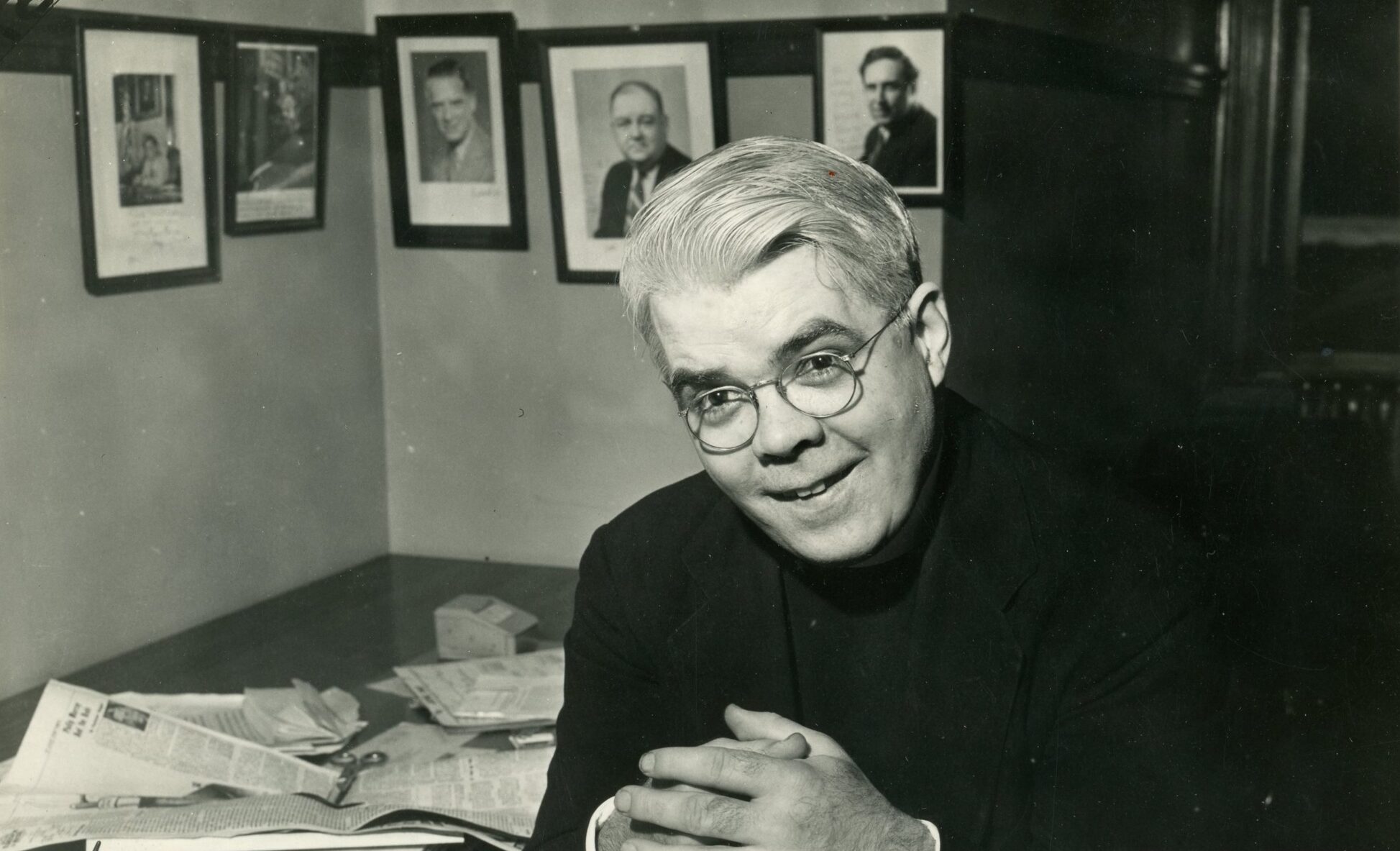Being fully human is complicated. Having a foot in both the material and spiritual worlds and with an originally good but fallen nature, our thoughts, motivations, and desires often come into conflict, and we don’t always choose what is best for us. Indeed, the decisions we make in our brokenness and complexity can have devastating consequences for ourselves and for others—poverty, addiction, shattered relationships, etc. The succinct but weighty question “What leads to human flourishing?” is in fact an array of complex questions regarding how to solve those problems.
Quite often, however, the solution to a problem is to see the person enduring it. This was the method employed by Fr. Edward Dowling, S.J., an American Jesuit who inspired Bill W. in his work with Alcoholics Anonymous (AA). Edward Patrick Dowling was born in 1898 in St. Louis and spent most of his life there. In 1919 he joined the Society of Jesus and was ordained in 1931. He spent time as a teacher during his formation and worked as the editor of the Queen’s Work magazine, an outreach of the Jesuits’ international Sodality of Our Lady that focused on spreading devotion to Mary, for many years after his ordination. In 1940 he discovered Alcoholics Anonymous through assisting an alcoholic friend, met Bill Wilson, and launched a lifelong mission of spreading what he saw as a deeply spiritual and effective recovery aid for those struggling to conquer addiction.
The story of this heretofore hidden hero of the Church has recently achieved greater prominence in the first biography of Dowling, Father Ed: The Story of Bill W.’s Spiritual Sponsor by Dawn Eden Goldstein. Published by Orbis Books in December 2022, the book reveals in 378 pages the life of a man whom Wilson called “the greatest human soul that I’m sure I shall ever know.” With depth and style, Goldstein unveils the figure of Dowling and honors his tireless devotion to helping “people with problems,” thereby offering inspiration and hope to modern readers on their own healing journey.
This biography is the first of its kind, and the research that went into it is meticulous and truly far-reaching. Goldstein lifts facts from contemporaneous newspapers and publications, conducts interviews with surviving family and friends, scours the Jesuit archives and Dowling’s personal correspondence, and even deciphers the order of events from extant personal calendars. She also offers well-reasoned explanations for any point about Dowling, Wilson, or the AA movement on which she differs from a prior source. The result is that Dowling comes alive in the pages as a vibrant, approachable, and faithful man of God whose concern for others amid their everyday difficulties impacted thousands of lives.
Based on the foreword, Goldstein seems to have written this book largely for herself as part of her own healing journey from childhood trauma. She also succeeds, however, in offering it to a much wider audience than just those seeking healing. This book is ideal for readers wanting to get a bigger picture of the AA movement and its beginnings, whether they are interested in AA on a historical or a personal level. It also provides a fascinating mid-20th-century snapshot of the Jesuit order in America for those interested. But it is on the whole commendable for ordinary readers wanting to be inspired by the story of a larger-than-life priest whose fatherly care helped many people find God in the midst of their brokenness.
I found the most interesting part of Father Ed to be its exposition of the connection Dowling saw between the 12-step program of Alcoholics Anonymous and the Spiritual Exercises of St. Ignatius. With his Jesuit formation, Dowling was well versed in the Exercises, so much so that he immediately recognized the parallels when he learned of the 12 steps. It was this connection that led him to seek out Bill Wilson and that endeared AA to him as a way to reach non-Catholic and even non-Christian souls with the spiritual nourishment of St. Ignatius’ guiding principles. As Goldstein puts it, “Father Ed therefore saw his ministry to AA members as akin to the work of an Ignatian spiritual director.” It was an opportunity for him to bring “spiritual liberation to people on a large scale.”
The spiritual element of the 12-step program has been commented on before. However, the specific resemblance of the Steps to the Spiritual Exercises seems to be a more novel claim. Goldstein lays out in detail some of the correlations Dowling saw, and any reader of faith who has had personal or familial experience with AA will find the connections she draws fascinating.
Another prominent theme of Father Ed is its emphasis on empathy as Dowling’s defining virtue. Goldstein continually describes instances of Dowling showing up for the people in his life, often taking the initiative to reach out to those he knew were in trouble and lending a listening ear when they sought him out. Despite his rigorous Jesuit training, “he never judged people who came to him for help according to whether they were Catholic or not.” For example, as evidenced throughout the book, he was a faithful friend and spiritual father to Bill W., who never took the leap of faith to join the Catholic Church despite his consistent attraction to it.
Goldstein highlights many other kinds of people to whom Dowling gave compassionate guidance in their personal struggles—certainly alcoholics but also those dealing with troubled marriages, spiritual scruples, mental disorders, drug addictions, same-sex attraction, and other difficulties. Dowling loved people and saw the desperate need of individuals both within and outside the Catholic Church to be heard, encouraged, and given tools to move forward in their lives. One friend called him an “ambassador at large to humanity,” and this seems to be his most significant legacy.
By Goldstein’s account, Father Ed was no stranger to suffering himself. In 1921, at the age of 23, he first began experiencing arthritis in his leg, which slowly worsened over the rest of his life until he could hardly walk without assistance. The calcification of his spine and corresponding debilitation, however, gave him a chance to learn from the “school of suffering” how to be conformed to Christ, and he took it. His wholehearted, joyful embrace of the sufferings that came his way exemplified to those he ministered to how to undergo their own “Glad Gethsemane” (as he phrased it).
Emphasized alongside Dowling’s profound empathy is his consistent orthodoxy. Throughout the book, Goldstein makes a concerted effort to show that “Dowling both was faithful to Catholic doctrine and made that doctrine come alive by applying it in ways that helped people find healing.” He had the gift of loving the sinner in a way that never conveyed approval of the sin. Dowling was passionate about sharing the Church’s teachings, particularly those related to issues of social justice. He was on the front lines combatting racism, political discrimination, and social exclusion of any kind, proclaiming the truth that each person is infinitely valuable. His vocal outcries against injustice sometimes shocked his audiences, but he gained popularity because he engaged people right in the midst of their ordinary difficulties, applying the time-tested truths of the Faith in accessible and novel ways.
This orthodoxy coexisting with a passion for social justice may spark questions in the reader regarding Father Ed’s influence on the Jesuit order in America. As Rachel Lu recently wrote in Law and Liberty: “The mid-20th-century Jesuits were not, as a group, particularly conservative or traditional. … Having always served a diverse and less-advantaged population of students, the Jesuits were naturally sympathetic to the early strains of diversity-and-inclusion rhetoric.” It’s not a stretch of the imagination to see Father Ed fitting this mold. While he seems to have adhered faithfully to Catholic doctrine, his massive efforts to promote democracy, equality, and fair treatment may have contributed to the reorienting of some swathes of the Jesuit order toward what would eventually be referred to as “woke” movements. This book does not comment on his legacy in that regard, which is a shame, as it would be fascinating to see where the threads might connect to some prominent left-leaning Jesuits of our own day.
Father Ed was ahead of his time not only in his passion for equality and fair treatment but also in his proclamation of the universal call to holiness. He emphasized (prior to its declaration in the documents of Vatican II) that living a life wholly dedicated to the Lord was not just for priests and vowed religious but for everyone: married, single, male, female, old, young. He encouraged those who came to him to seek to grow closer to the Lord in their daily lives and offered them practical advice for how to do this—for example, he counseled Catholics to receive the Eucharist frequently so that they might be strengthened by grace in their sufferings.
If I have one criticism of the book, it’s that it is almost too uncritical. The laudatory tone Goldstein adopts in describing Dowling can sound a bit biased on occasion, though the painstaking documentation she provides certainly lends credence to her adulation. Another thing that could bother some readers is the insertion into the narrative of the thoughts and feelings of Dowling and other characters as particular events unfold. Some may find it helps their imaginations absorb the scenes in a more robust way; others may wish only for the bare facts without speculation on the subject’s mental state, predictable as the latter may seem to be.
Toward the end of the book, Goldstein describes the regularity with which a steady stream of individuals from all walks of life would stop by the Queen’s Work headquarters to seek advice from Father Ed. I was reminded of the scene from the recently released film Father Stu where another priest with debilitating illness had a line out the door of visitors waiting for him to speak wisdom into their difficult life circumstances. It seems that Father Ed could very well be the next priest whose inspiring life story is told on the big screen, if Goldstein’s biography generates enough stir. Consider this my contribution in that regard.

